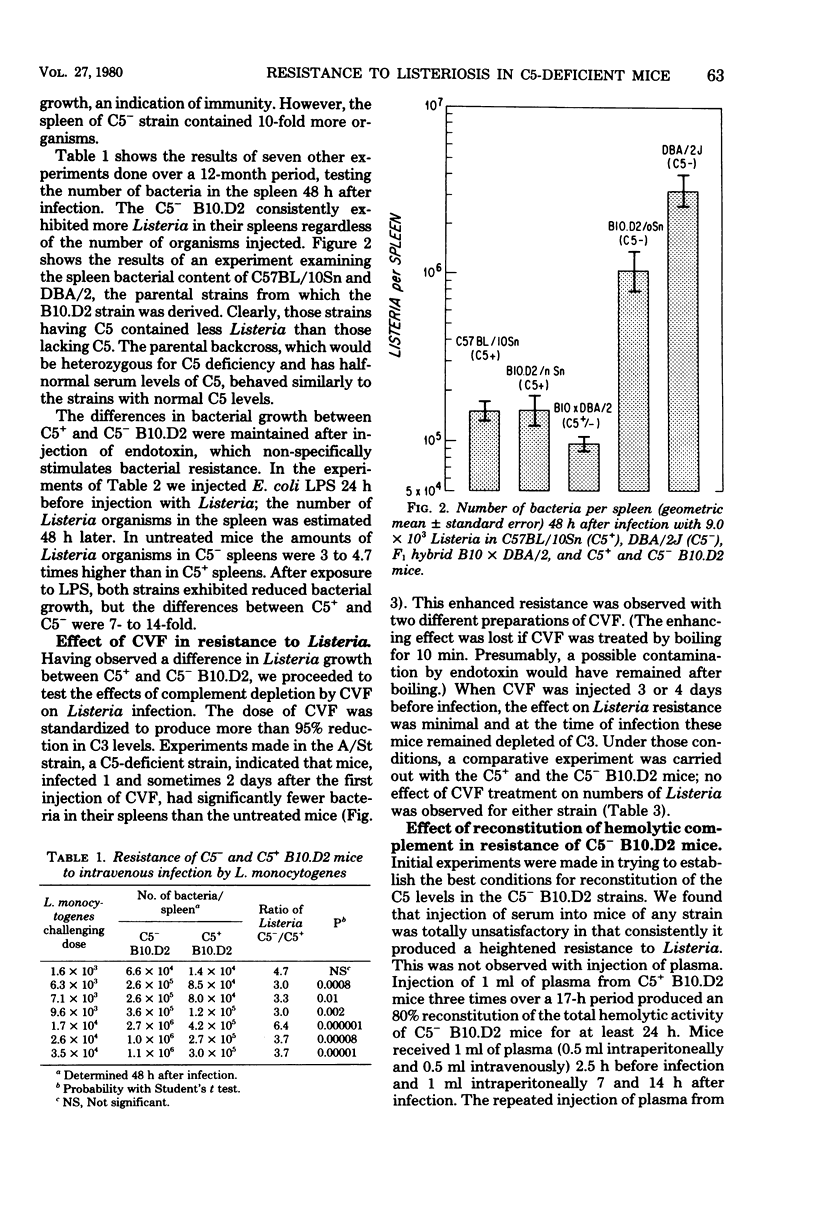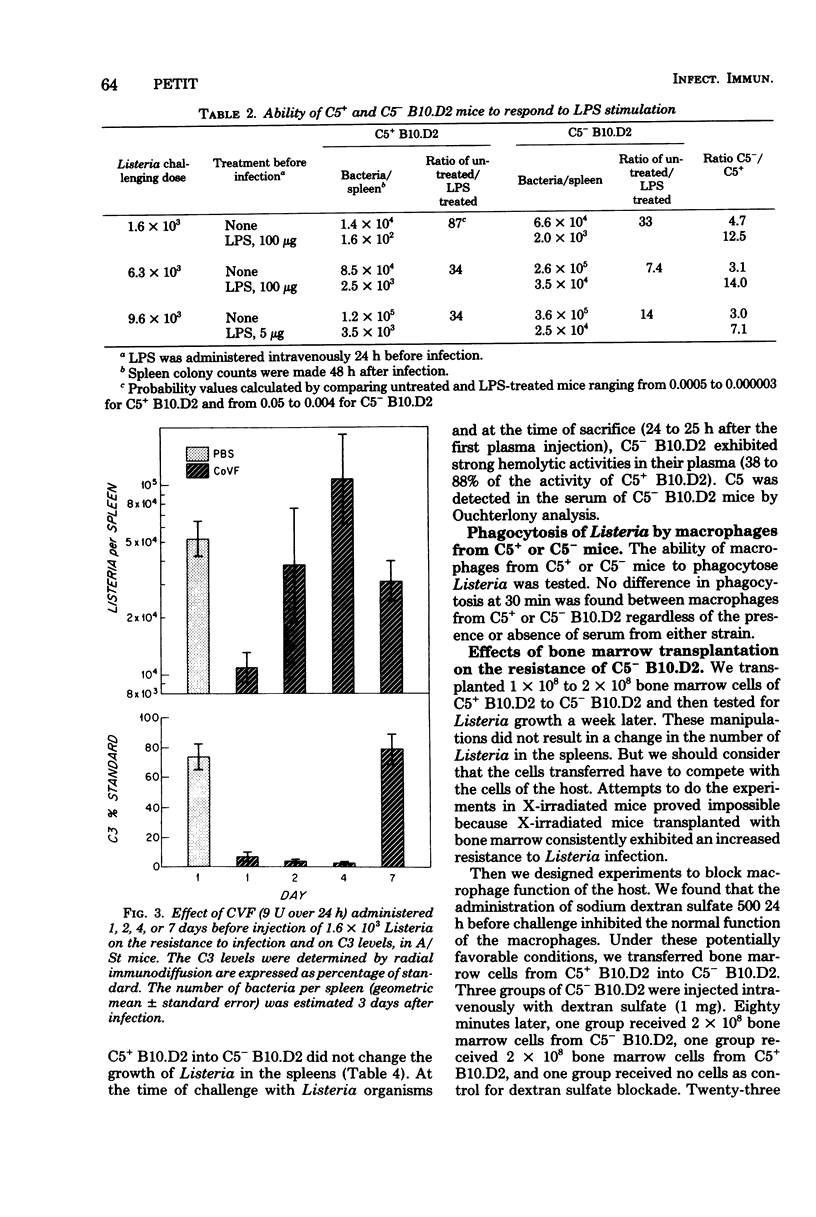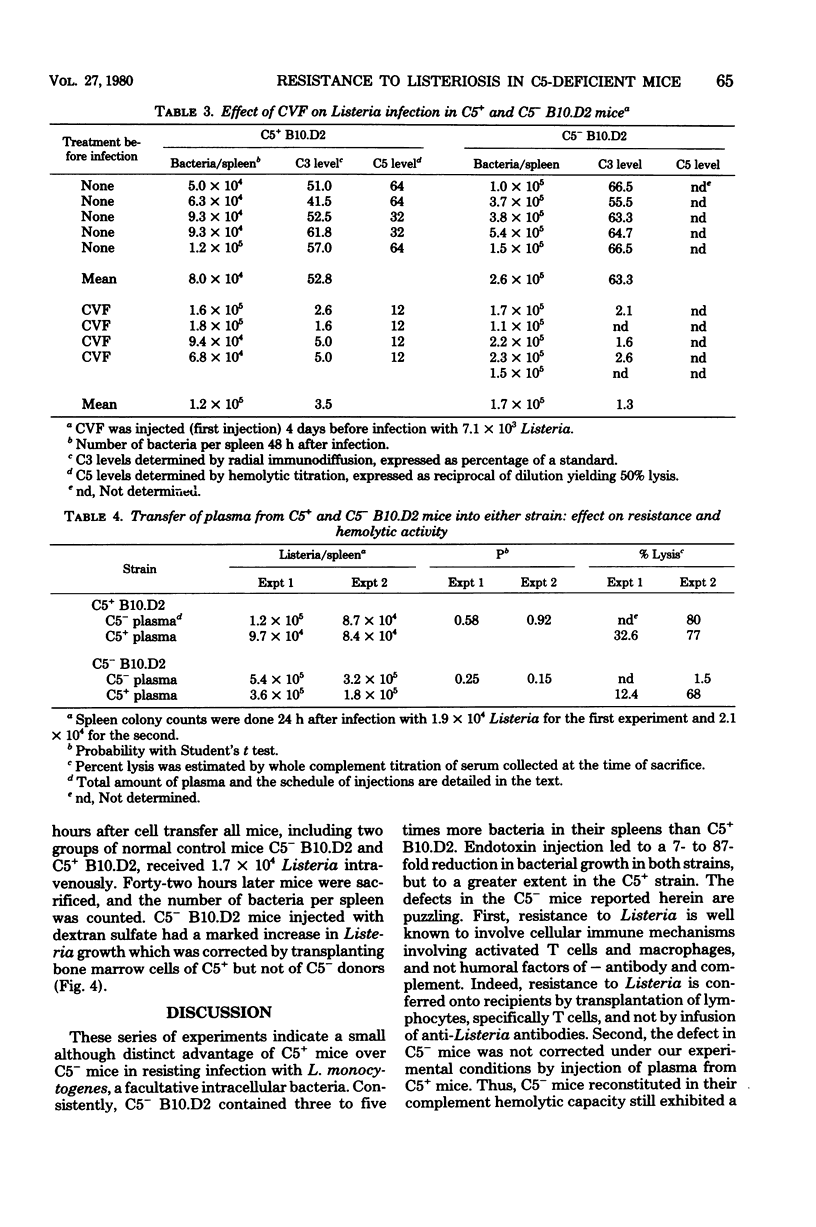Abstract
Infection with Listeria monocytogenes was studied in strains of mice with genetic absence of the fifth component of complement (C5). Mice deficient in C5 consistently showed an increased growth of Listeria in their spleens as compared to normal mice. This increased growth was not corrected by administration of plasma containing C5. Furthermore, depletion of C5 and terminal complement components by administration of cobra venom factor did not impair the resistance to Listeria infection of normal mice. No phagocytic defect could be detected in macrophages from strains lacking C5. Transfer of bone marrow cells from C5+ but not from C5- mice corrected the marked increase of Listeria growth in mice having blockade of the reticuloendothelial system. We hypothesize that the defect of mice lacking C5 lies not in the absence of serum C5 but somewhere at the level of the macrophage.
Full text
PDF






Selected References
These references are in PubMed. This may not be the complete list of references from this article.
- CINADER B., DUBISKI S. AN APLHA-GLOBULIN ALLOTYPE IN THE MOUSE (MUB1). Nature. 1963 Nov 23;200:781–781. doi: 10.1038/200781a0. [DOI] [PubMed] [Google Scholar]
- Caren L. D., Rosenberg L. T. Complement in skin grafting in mice. Immunology. 1965 Oct;9(4):359–364. [PMC free article] [PubMed] [Google Scholar]
- Caren L. D., Rosenberg L. T. The role of complement in resistance to endogenous and exogenous infection with a common mouse pathogen, Corynebacterium kutscheri. J Exp Med. 1966 Oct 1;124(4):689–699. doi: 10.1084/jem.124.4.689. [DOI] [PMC free article] [PubMed] [Google Scholar]
- ERICKSON R. P., TACHIBANA D. K., HERZENBERG L. A., ROSENBERG L. T. A SINGLE GENE CONTROLLING HEMOLYTIC COMPLEMENT AND A SERUM ANTIGEN IN THE MOUSE. J Immunol. 1964 Apr;92:611–615. [PubMed] [Google Scholar]
- Easmon C. S., Glynn A. A. Comparison of subcutaneous and intraperitoneal staphylococcal infections in normal and complement-deficient mice. Infect Immun. 1976 Feb;13(2):399–406. doi: 10.1128/iai.13.2.399-406.1976. [DOI] [PMC free article] [PubMed] [Google Scholar]
- HERZENBERG L. A., TACHIBANA D. K., HERZENBERG L. A., ROSENBERG L. T. A gene locus concerned with hemolytic complement in Mus musculus. Genetics. 1963 May;48:711–715. doi: 10.1093/genetics/48.5.711. [DOI] [PMC free article] [PubMed] [Google Scholar]
- Hahn H., Bierther M. Morphological changes induced by dextran sulfate 500 in mononuclear phagocytes of listeria-infected mice. Infect Immun. 1974 Nov;10(5):1110–1119. doi: 10.1128/iai.10.5.1110-1119.1974. [DOI] [PMC free article] [PubMed] [Google Scholar]
- Hahn H. Effects of Dextran Sulfate 500 on Cell-Mediated Resistance to Infection with Listeria monocytogenes in Mice. Infect Immun. 1974 Nov;10(5):1105–1109. doi: 10.1128/iai.10.5.1105-1109.1974. [DOI] [PMC free article] [PubMed] [Google Scholar]
- Lane F. C., Petit J. C., Gordon E., Unaue E. R. Increased bactericidal activity by non-specific stimulation of lymphoid cells--experiments in vivo with concanavalin A. Clin Immunol Immunopathol. 1973 Nov;2(1):74–81. doi: 10.1016/0090-1229(73)90038-x. [DOI] [PubMed] [Google Scholar]
- Lane F. C., Unanue E. R. Requirement of thymus (T) lymphocytes for resistance to listeriosis. J Exp Med. 1972 May 1;135(5):1104–1112. doi: 10.1084/jem.135.5.1104. [DOI] [PMC free article] [PubMed] [Google Scholar]
- Lawrence D. A., Schell R. F. Susceptibility of C5-deficient mice to listeriosis: modulation by Concanavalin A. Cell Immunol. 1978 Sep;39(2):336–344. doi: 10.1016/0008-8749(78)90109-0. [DOI] [PubMed] [Google Scholar]
- Levy N. L., Synderman R., Ladda R. L., Lieberman R. Cytogenetic engineering in vivo: restoration of biologic complement activity to C5-deficient mice by intravenous inoculation of hybrid cells. Proc Natl Acad Sci U S A. 1973 Nov;70(11):3125–3129. doi: 10.1073/pnas.70.11.3125. [DOI] [PMC free article] [PubMed] [Google Scholar]
- MACKANESS G. B. Cellular resistance to infection. J Exp Med. 1962 Sep 1;116:381–406. doi: 10.1084/jem.116.3.381. [DOI] [PMC free article] [PubMed] [Google Scholar]
- MARDINEY M. R., Jr, MUELLER-EBERHARD H. J. MOUSE BETA-1C-GLOBULIN: PRODUCTION OF ANTISERUM AND CHARACTERIZATION IN THE COMPLEMENT REACTION. J Immunol. 1965 Jun;94:877–882. [PubMed] [Google Scholar]
- MIKI K., MACKANESS G. B. THE PASSIVE TRANSFER OF ACQUIRED RESISTANCE TO LISTERIA MONOCYTOGENES. J Exp Med. 1964 Jul 1;120:93–103. doi: 10.1084/jem.120.1.93. [DOI] [PMC free article] [PubMed] [Google Scholar]
- Mackaness G. B. The influence of immunologically committed lymphoid cells on macrophage activity in vivo. J Exp Med. 1969 May 1;129(5):973–992. doi: 10.1084/jem.129.5.973. [DOI] [PMC free article] [PubMed] [Google Scholar]
- Morelli R., Rosenberg L. T. Role of complement during experimental Candida infection in mice. Infect Immun. 1971 Apr;3(4):521–523. doi: 10.1128/iai.3.4.521-523.1971. [DOI] [PMC free article] [PubMed] [Google Scholar]
- Morelli R., Rosenberg L. T. The role of complement in the phagocytosis of Candida albicans by mouse peripheral blood leukocytes. J Immunol. 1971 Aug;107(2):476–480. [PubMed] [Google Scholar]
- Müller-Eberhard H. J., Fjellström K. E. Isolation of the anticomplementary protein from cobra venom and its mode of action on C3. J Immunol. 1971 Dec;107(6):1666–1672. [PubMed] [Google Scholar]
- Nilsson U. R., Müller-Eberhard H. J. Deficiency of the fifth component of complement in mice with an inherited complement defect. J Exp Med. 1967 Jan 1;125(1):1–16. doi: 10.1084/jem.125.1.1. [DOI] [PMC free article] [PubMed] [Google Scholar]
- Petit J. C., Unanue E. R. Effects of bacterial products on lymphocytes and macrophages: their possible role in natural resistance to listeria infetion in mice. J Immunol. 1974 Sep;113(3):984–992. [PubMed] [Google Scholar]
- Phillips M. E., Rother U. A., Rother K. O., Thorbecke G. J. Studies on the serum proteins of chimeras. 3. Detection of donor-type C'5 in allogeneic and congenic post-irradiation chimeras. Immunology. 1969 Aug;17(2):315–321. [PMC free article] [PubMed] [Google Scholar]
- Ruddy S., Klemperer M. R., Rosen F. S., Austen K. F., Kumate J. Hereditary deficiency of the second component of complement (C2) in man: correlation of C2 haemolytic activity with immunochemical measurements of C2 protein. Immunology. 1970 Jun;18(6):943–954. [PMC free article] [PubMed] [Google Scholar]
- Shin H. S., Smith M. R., Wood W. B., Jr Heat labile opsonins to pneumococcus. II. Involvement of C3 and C5. J Exp Med. 1969 Dec 1;130(6):1229–1241. doi: 10.1084/jem.130.6.1229. [DOI] [PMC free article] [PubMed] [Google Scholar]
- Snyderman R., Pike M. C., McCarley D., Lang L. Quantification of mouse macrophage chemotaxis in vitro: role of C5 for the production of chemotactic activity. Infect Immun. 1975 Mar;11(3):488–492. doi: 10.1128/iai.11.3.488-492.1975. [DOI] [PMC free article] [PubMed] [Google Scholar]
- Snyderman R., Shin H., Dannenberg A. M., Jr Macrophage proteinase and inflammation: the production of chemotactic activity from the fifth complement by macrophage proteinase. J Immunol. 1972 Oct;109(4):896–898. [PubMed] [Google Scholar]


